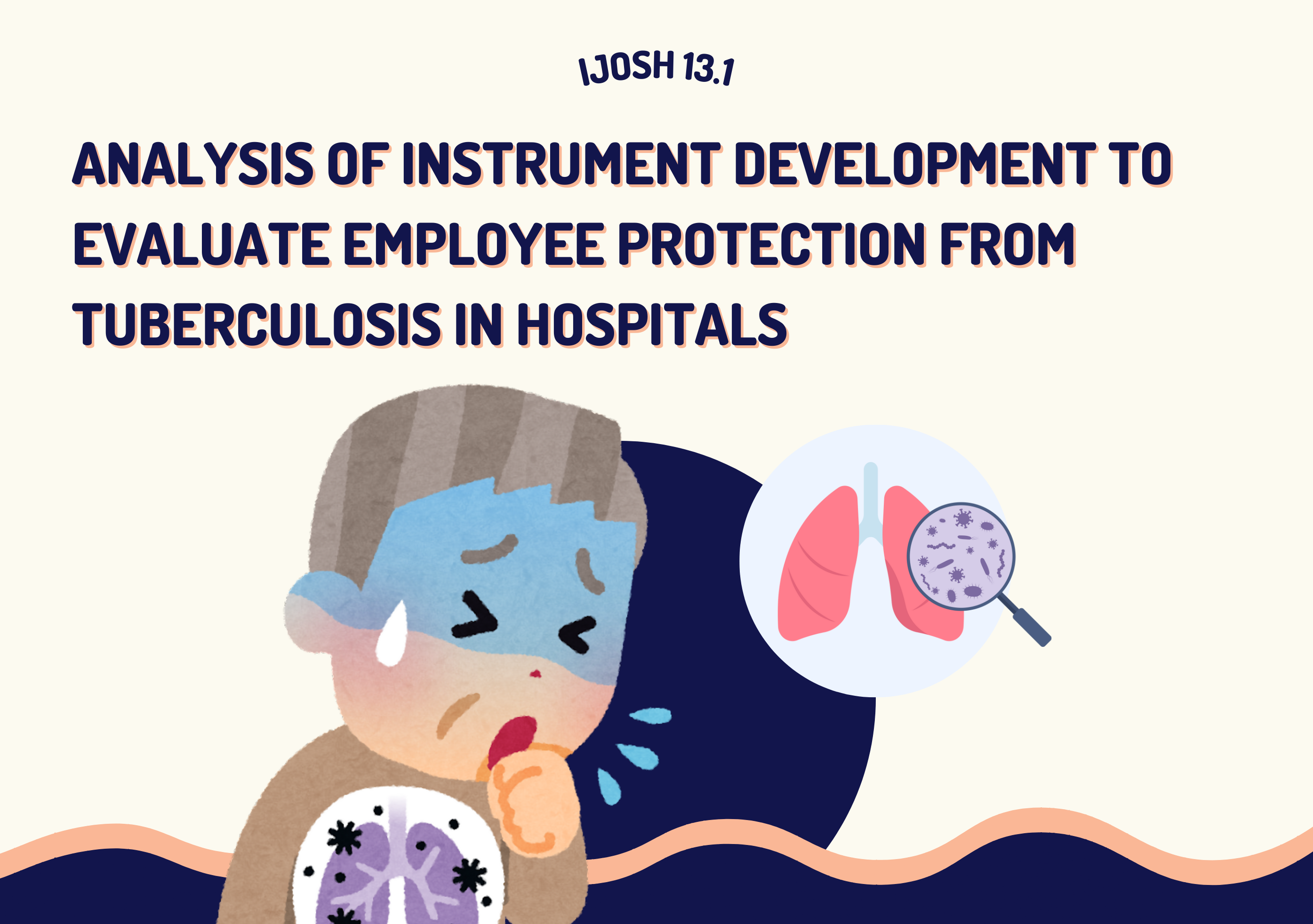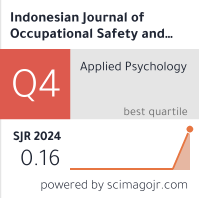Analysis of Instrument Development to Evaluate Employee Protection from Tuberculosis in Hospitals

Downloads
Introduction: Tuberculosis (TB) continues to be a major global public health threat, affecting millions of people annually. Despite efforts to control TB, the number of cases remains high. The situation is exacerbated by the COVID-19 pandemic, which has strained healthcare systems. The increased workload of hospital employees also raises the risk of TB transmission. This study aims to develop an instrument to evaluate employee protection from TB in hospitals. Methods: This study used a qualitative design with an exploratory approach. Data were collected from existing policies and through in-depth interviews with stakeholders, including academics, practitioners, regulators, infection control officers, occupational health and safety officers, and non-government organization representatives for TB. Results: The instrument developed comprised seven components, namely management commitment; program planning; coordination, communication, and education; implementation of TB and other disease management programs in the workplace; handling TB cases in the workforce; training and competence; and monitoring and evaluation. Conclusion: Instrument development is crucial for capturing the current state of TB problems and managing prevention and control programs in hospitals. The terms of reference serve as an effort to protect hospital employees
Apriani, L. et al. (2022) ‘Tuberculosis Infection Control Measures and Knowledge in Primary Health Centres in Bandung, Indonesia', Journal of Infection Prevention, 23(2), pp. 49–58.
Cabral, V.K. et al. (2021) ‘The use of Information and Communication Technology in Continuing Education in Tuberculosis', Journal of European CME, 10(1), p. 1930962.
Cohen, R. et al. (2022) ‘Translating a Theory-based Positive Deviance Approach Into an Applied Tool: Mitigating Barriers among Health Professionals (HPs) Regarding Infection Prevention and Control (IPC) Guidelines', Plos One, 17(6), p. e0269124.
Deryabina, A. et al. (2021) ‘Core Components of Infection Prevention and Control Programs at the Facility Level in Georgia: Key Challenges and Opportunities', Antimicrobial Resistance & Infection Control, 10(1), pp. 1–20.
Islam, M.S. et al. (2022) ‘Examining Pulmonary TB Patient Management and Healthcare Workers Exposures in Two Public Tertiary Care Hospitals, Bangladesh', PLOS Global Public Health, 2(1), p. e0000064.
Johnston, B.L. et al. (2022) ‘Chapter 14: Prevention and Control of Tuberculosis Transmission in Healthcare Settings', Canadian Journal of Respiratory, Critical Care, and Sleep Medicine, 6(sup1), pp. 205–228.
Macdonald, H. and Harper, I. (2019) Understanding Tuberculosis and Its Control: Anthropological and Ethnographic Approaches. Routledge.
Mandal, S. (2022) ‘Towards Building a Tuberculosis Free World', Indian Journal of Tuberculosis, pp. 259–261.
Manoharan, A. et al. (2023) ‘Facilitators and Barriers to Latent Tuberculosis Infection Treatment among Primary Healthcare Workers in Malaysia: A Qualitative Study', BMC Health Services Research, 23(1), p. 914.
Martha, E. and Kresno, S. (2016) ‘Metodologi Penelitian Kualitatif'. Jakarta: Rajawali Press.
Noviana, A.C. et al. (2022) ‘Tuberkulosis Laten pada Tenaga Kesehatan di RSI Jemur Sari Surabaya', Jurnal Ilmiah Kesehatan Masyarakat: Media Komunikasi Komunitas Kesehatan Masyarakat, 14(1), pp. 30–34.
Oktamianti, P. et al. (2021) ‘Tuberculosis Control within Indonesia's Hospital Accreditation', Journal of Public Health Research, 10(3), pp. 1-5.
Paleckyte, A. et al. (2021) ‘Reducing the risk of tuberculosis transmission for HCWs in high incidence settings', Antimicrobial Resistance & Infection Control, 10(1), pp. 1–11.
Pancho Kaslam, D.R.M. et al. (2021) Buku Pedoman Pencegahan Pengendalian Infeksi. Depok: Universitas Indonesia Publishing.
Pulungan, R.M. and Permatasari, P. (2021) ‘Predisposing and Enabling Factors Relationship with Successful Treatment of Pulmonary Tuberculosis (TB)', Jurnal Kesehatan Prima, 15(1), pp. 57–67.
Ratchakit-Nedsuwan, R. et al. (2020) ‘Ensuring Tuberculosis Treatment Adherence with a Mobile-based CARE-call System in Thailand: a Pilot Study', Infectious Diseases, 52(2), pp. 121–129.
Sharma, D. et al. (2018) ‘Prevalence and risk factors of tuberculosis in developing countries through Health Care Workers', Microbial pathogenesis, 124, pp. 279–283.
Sugiyono (2017) Metode penelitian kuantitatif, kualitatif, dan R&D. Bandung: Alfabeta.
Swaminathan, N., Perloff, S.R. and Zuckerman, J.M. (2021) ‘Prevention of Mycobacterium Tuberculosis Transmission in Health Care Settings', Infectious Disease Clinics, 35(4), pp. 1013–1025.
Tendolkar, M.S., Tyagi, R. and Handa, A. (2021) ‘Review of Advances in Diagnosis and Treatment of Pulmonary Tuberculosis', Indian Journal of Tuberculosis, 68(4), pp. 510–515.
Vigenschow, A. et al. (2021) ‘Knowledge, Attitudes and Practices Regarding Tuberculosis amongst Healthcare Workers in Moyen-Ogooué Province, Gabon', BMC Infectious Diseases, 21(1), pp. 1–7.
Wang, Z. et al. (2019) ‘Transforming Tuberculosis (TB) Service Delivery Model in China: Issues and Challenges for Health Workforce', Human Resources for Health, 17, pp. 1–10.
WHO (2020) ‘Keep health workers safe to keep patients safe: WHO', World Health Organization. Available at: https://www.who.int/news-room/detail/17-09-2020-keep-health-workers-safe-to-keep-patients-safe-who (Accessed: 30 November 2023).
WHO (2022) WHO Global TBC Report 2022, https://www.who.int/teams/global-tuberculosis-programme/tb-reports/global-tuberculosis-report-2022.
Yunita, S. (2021) ‘Pengaruh Penerapan Instrumen Ppi Snars Terhadap Kesejahteraan Psikologis Petugas Penanggulangan COVID-19', JINTAN: Jurnal Ilmu Keperawatan, 1(2), pp. 91–102.

This work is licensed under a Creative Commons Attribution-NonCommercial-ShareAlike 4.0 International License.

In order to be accepted and published by The Indonesian Journal of Occupational Safety and Health, Author(s) who submit an article should complete all the review process. The copyright of received articles assigned to the The Indonesian Journal of Occupational Safety and Health and Department of Safety and Health, Universitas Airlangga as publishers of the journal. The intended copyright includes the rights to publish articles in various forms (including reprints).
The Editorial Team of The Indonesian Journal Of Occupational Safety and Health and Department of Safety and Health strive to ensure that no errors occur in the articles that have been published, both data errors and statements in the article.
Users of this website will be licensed to use materials from this website following the Creative Commons Attribution-NonCommercial-ShareAlike 4.0 International License. No fees charged. Please use the materials accordingly.
------------------------------------------------------------------------------------------------------------------------------------------------------------------------------------------
Attribution ” You must give appropriate credit, provide a link to the license, and indicate if changes were made. You may do so in any reasonable manner, but not in any way that suggests the licensor endorses you or your use.
NonCommercial ” You may not use the material for commercial purposes.
ShareAlike ” If you remix, transform, or build upon the material, you must distribute your contributions under the same license as the original.







 How to Submit Articles in OJS
How to Submit Articles in OJS

























